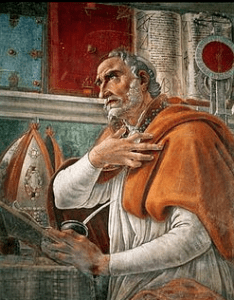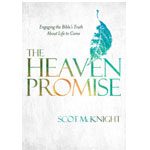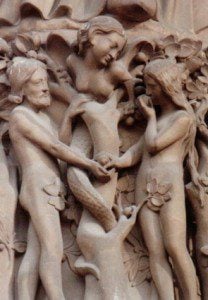 The last two church fathers considered by Peter Bouteneff in his book Beginnings: Ancient Christian Readings of the Biblical Creation Narratives are Gregory of Nazianzus and Gregory of Nyssa. These two, along with Basil introduced in the posts last week, are known collectively as the Cappodocian Fathers.
The last two church fathers considered by Peter Bouteneff in his book Beginnings: Ancient Christian Readings of the Biblical Creation Narratives are Gregory of Nazianzus and Gregory of Nyssa. These two, along with Basil introduced in the posts last week, are known collectively as the Cappodocian Fathers.
Basil was bishop of Caesarea Mazaca in Cappadocia. (The image to the right from wikipedia is Mt. Erciyes, a rather substantial volcano about 25 km south of Caesarea Mazaca). Gregory Nazianzus was a contemporary and friend of Basil and archbishop of Constantinople, Gregory Nyssa was Basil’s brother and bishop of Nyssa. They both continued writing, preaching, and reflecting on scripture following the death of Basil in 379. Nazianzus for another decade and Nyssa until the mid 390’s. As with Basil, their approach was influenced by the controversies of the day, especially the Arian controversy. They were concerned to demonstrate that God was not the author of evil and that scripture was Christ centered. Nazianzus in particular was focused on preaching and his work is aimed at the common man. We have orations from Gregory Nazianzus, not scholarly treatises.
With respect to the question of beginnings, the focus of Bouteneff’s book, one important issue to consider for each of the early church fathers is their approach to the interpretation of scripture. Both Nazianzus and Nyssa took a stand over and against the excessive allegorization of scripture. Nonetheless both saw the sense of scripture as multi-layered and scripture could be interpreted historically, allegorically, or typologically. Their approaches to the creation narratives are summarized below.
 Gregory of Nazianzus (The Theologian) dealt with Genesis 1 only rarely, he was not particularly interested in the question of origins. He dealt with the paradise narrative more frequently, but not in a search for the origin of sin. He used Eve as he reflected on humans as gendered beings. He did so in a way that was both reflective of his culture, where physical strength, moral strength, and courage were viewed as masculine attributes, and ran counter to it with emphasis on equality in the face of God, and a realization that gender does determine personal character. He was, Bouteneff points out, sensitive to the plight of women in his society and pointed out to the men in his audience that “The serpent deceived them both; and not one was found to be the stronger and the other the weaker” and “Christ saves the both by his Passion. Was he made flesh for the man? So He was also for the woman. Did he die for the man? The woman is also saved by his death. … The two, he says, shall be one flesh; so let the one flesh have equal honor.” You can find this in Oration 37.7. The translation I’ve linked both here and below is an old one – Boutneff’s is modern.
Gregory of Nazianzus (The Theologian) dealt with Genesis 1 only rarely, he was not particularly interested in the question of origins. He dealt with the paradise narrative more frequently, but not in a search for the origin of sin. He used Eve as he reflected on humans as gendered beings. He did so in a way that was both reflective of his culture, where physical strength, moral strength, and courage were viewed as masculine attributes, and ran counter to it with emphasis on equality in the face of God, and a realization that gender does determine personal character. He was, Bouteneff points out, sensitive to the plight of women in his society and pointed out to the men in his audience that “The serpent deceived them both; and not one was found to be the stronger and the other the weaker” and “Christ saves the both by his Passion. Was he made flesh for the man? So He was also for the woman. Did he die for the man? The woman is also saved by his death. … The two, he says, shall be one flesh; so let the one flesh have equal honor.” You can find this in Oration 37.7. The translation I’ve linked both here and below is an old one – Boutneff’s is modern.
In Oration 38 On the Theophany, or Birthday of Christ Nazainzus presents his understanding of creation and redemption. God first created the heavenly realm, and then the material realm – and placed man in the material realm.
This being He placed in Paradise, whatever the Paradise may have been, having honoured him with the gift of Free Will (in order that God might belong to him as the result of his choice, no less than to Him who had implanted the seeds of it), … Also He gave him a Law, as a material for his Free Will to act upon. This Law was a Commandment as to what plants he might partake of, and which one he might not touch. (NPNF2-07 348)
Nazianzus was not emphatic on the nature of the garden. Speculation on this point, while apparently common among Christian thinkers of his day, was unnecessary for the message he wished to convey to the people in his audience. The man and woman placed in Paradise were immature. Their act in the garden was not defiance or rebellion, rather the woman succumbed to the Devil’s malice and the man forgot the commandment. They were malleable and lacked the maturity and wisdom to resist the Devil’s persuasion or to handle the knowledge of good and evil. The tree itself was not bad – but the time was not right.
Bouteneff’s summary:
He cannot but be mindful of the “interweavings” of historical and allegorical narrative within Scripture, specifically within the paradise narrative. He doesn’t feel pressed to establish Adam, Eve, the tree, and the serpent as concretely existing phenomena or categorize them as symbolic.
…
Primarily, however, Adam, Eve, and paradise are a collective reference point for human creation and sin, although always with primary reference to the responsibility of each individual human. This, together with the speculative character of the Theologian’s exegesis of the paradise narrative, serves to underscore what really mattered to Gregory in this complex and beautiful biblical narrative. Paradise and Adam are ultimately about us and our sin, a story that has its fulfillment in our recreation in Christ, the second Adam. (p. 151)
While Gregory Nazianzus’s focus was on his preaching and teaching, Gregory of Nyssa was somewhat more concerned with precise theological ideas.
 Gregory of Nyssa was not entirely consistent in his approach to scripture – he moved between a historical and an allegorical approach. His approach also changed somewhat throughout the different phases of his career. With respect to the trees in the garden he notes that both cannot be in the center, although the text says that they are. He uses this as an excuse to beyond the surface and explore the depth of meaning in the Paradise narrative.
Gregory of Nyssa was not entirely consistent in his approach to scripture – he moved between a historical and an allegorical approach. His approach also changed somewhat throughout the different phases of his career. With respect to the trees in the garden he notes that both cannot be in the center, although the text says that they are. He uses this as an excuse to beyond the surface and explore the depth of meaning in the Paradise narrative.
To Gregory this can mean only that in such cases we must contemplate the truth of the story “through philosophy” (διὰ ϕιλοσοϕίας), or else the text will “either be incoherent or a fable [ἀσύστατον ἢ μυθῶδες]” (GNO 6:11) Genesis 3:3 in the LXX is easy enough to interpret in terms of two trees “in the midst,” or even “in the middle,” of the garden; surely, Gregory was simply seeking the excuse to treat the trees spiritually. He found a “stumbling block” to lead us, as Origen said that it would, deeper into the meaning of Scripture. (p. 153)
And a little later Bouteneff summarizes:
For Gregory, history and allegory do not reside within airtight compartments. They are interpenetrating ways to look at the scriptural narrative. Once again, although Gregory does not suggest discarding the basic historical narrative, in his reading it takes second place or at least requires a different kind of analysis to be understood rightly. (p. 154)
Gregory does not see the creation narrative as a scientific treatment of creation – but nonetheless a true presentation of a real material creation. For example, he asserts that water is water in the creation narrative – not a term to be searched for some deeper significance and meaning.
Gregory wrote at length on the nature of Adam and on the two natures of creation. He separates the intelligible creation from the sensible creation. The initial creation is purely conceptual (intelligible) and it is then realized in substance (sensible). Two questions drive much of Gregory’s discussion: “How can God have created a humanity that suffers and sins and still be considered good, all-knowing, and all powerful?” and “How can the human person, who is mortal, passionate, and gendered, be said to be in the image of the immortal, dispassionate, and genderless God?” (p. 157-1658) The way Gregory wrestled with these questions led him to interpret “the creation narrative to show that God conceived the sum total of creation in an instant and then brought it into being over time until that fullness was realized. (p. 165)” God both had prescient knowledge of the fall and foreknew its restoration. Free will and redemption are both part of the plan.
(I have not linked directly any quotes from Gregory of Nyssa – but a collection of his work is also found in Nicene and Post Nicene Fathers 2 – available online and as pdf files: NPNF2-05.)
A summary of the Cappadocian Fathers. Bouteneff summarizes his chapter on Basil and the two Gregorys:
All three of the Cappadocians exulted in the glory and mystery of the created world and its microcosmic summation in the human person; they saw in creation the clear sign of an all-loving, all-wise Creator who providentially orders and oversees his work. … all three also retained what became the common patristic emphasis on the paraenetic teaching, and the clear focus on Christ, the center of one’s rule of faith. … [They] were so focused on the work of the Savior that their teaching on creation and on the generation of humanity was narrated exclusively through the lens of regeneration, or restoration, in Christ. (p. 168)
A deep respect for scripture, a sense of both history and allegory in the narrative, a consideration of creation in light of the knowledge of the day, and most importantly, a Christ-centered focus, characterize the work of all three of the Cappadocian fathers. Neither a wooden literalism in the reading of scripture nor an emphasis on an inherited effect of Adam’s fall is to be found in their work.
Is it important that we correctly determine the genre of a passage, be it Genesis 1-3, Job, Jonah or Song of Songs, as history, allegory, story, or parable?
Is there a time to step back with Gregory Nazianzus and admit that it doesn’t matter “whatever the Paradise may have been”?
If you would like to contact me directly you may do so at rjs4mail[at]att.net.
If interested you can subscribe to a full text feed of my posts at Musings on Science and Theology.











